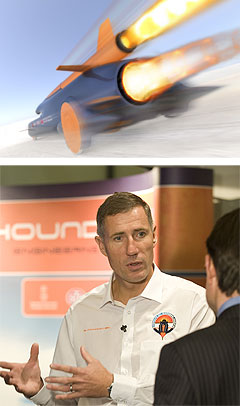Australia could host land speed attempt
BY JAMES STANFORD | 27th Jan 2009

The Bloodhound SSC team is considering Lake Eyre and Lake Gairdner in South Australia as possible locations for the attempt using a new hybrid machine powered by a jet engine, rocket and a 4.2-litre V12 engine.
Lake Eyre is the salt lake bed used by British speed legend Donald Campbell to break the land speed record in 1964.
Bloodhound SSC holds the existing land speed record of 1228 km/h set in the Black Rock Desert, Nevada, in 1997 using the Thrust SSC vehicle.

The man who drove that car, the first to officially break the sound barrier, is RAF pilot Andy Green.
He is examining several locations for the land speed record attempt and has just finished visiting Australian salt lake beds. Mr Green has just finished a report in which he states that Lake Eyre and Lake Gairdner are both possible locations for the record attempt if they are dry enough. He noted that December rain meant significant parts of the lake bed were currently too moist.
“The main concern now is how often do these surfaces dry?” he writes on the Bloodhoundssc.com website.
“Both have had problems in the past: the dry lake racers have cancelled their meeting at Lake Gairdner for the last two years due to rain, while Rosco McGlashan (Australian land speed record holder) based his team there for a year and never got the ideal salt conditions he was waiting for,” he said.
“Donald Campbell spent much of 1963/4 at Lake Eyre, also waiting for the perfect conditions that never came. He still managed a World Land Speed Record of 403mph (649km/h), but his Bluebird was probably capable of over 450mph (724km/h) if the salt had been better.” He concluded that the team should watch the progress of the lakes closely.
“Both lakes looked like they could be fantastic LSR (land speed record) venues, but Australia is a long way to go if you get unlucky with the weather.” The Bloodhound SSC team has been developing its new land speed record machine for 18 months, but has gone public in a bid to raise capital.
It has come up with a completely different machine to the one used for the current record.
That vehicle used two Rolls-Royce Spey turbo-fan jet engines with afterburners.
The new car uses an EJ200 turbo jet engine from the British Eurofighter Typhoon fighter to provide half the boost. A hybrid rocket provides the rest.
Bloodhound SSC originally planned to use only the rocket, but soon realised that such a vehicle would be too hard to control.
The new design sees the rocket being used as an additional powerplant once the jet engine has wound up.
Instead of using a solid rocket, the type used for space shuttle lift-offs, the Bloodhound SSC system is a Falcon liquid hybrid which stores the rocket fuel in a separate aluminum tank and feeds it in as required.
The benefit of this system is that it can be shut down safely during the run should anything go wrong as opposed to a solid rocket which can’t be turned off once lit.
The rocket’s primary fuel is a synthetic rubber called Hydroxyl-Terminated Polybutadiene (HTBP), while concentrated hydrogen peroxide (HTP) acts as the oxidizer.
It can generate up to 122kN (or 27,500lb) of thrust using 181kg of fuel and can run for up to 20 seconds.
The HTP must be fed into the combustion chamber quickly, so the Bloodhound SSC is using a 4.5-litre Menard-built racing petrol-powered V12 as a massively powerful fuel pump.
Revving at 12,000rpm and generating 462kW, it can pump 50.3kg of HTP per second, delivering it into the chamber at 75.8 Bar.
The petrol engine also acts as the Bloodhound SSC auxiliary power unit, providing electrical and hydraulic power.
Bloodhound SSC is one of several teams developing a vehicle with the aim of setting a new land speed record.
Read more:
Diesel hits new heightsbr>